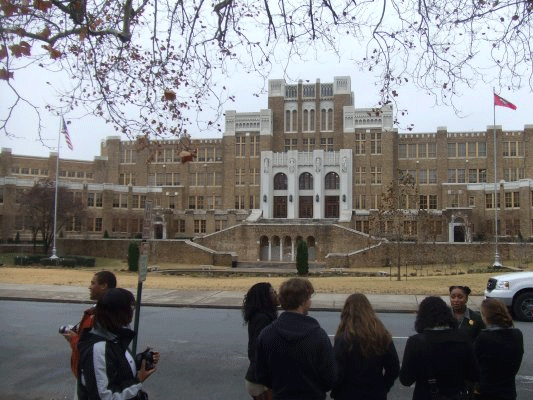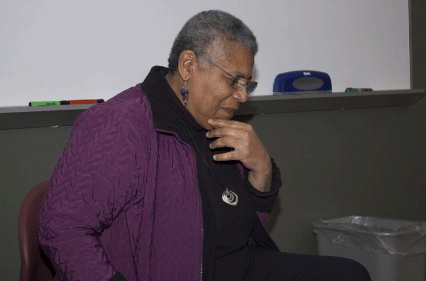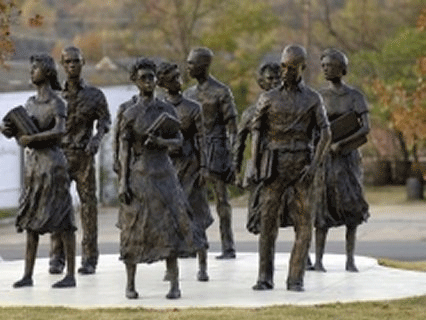 For many of us, Little Rock was a much anticipated destination. We had grown up hearing about the Little Rock Nine, and the image of Elizabeth Eckford, the 15-year-old in the crisply starched white dress with black gingham trim, hounded by screaming mobs as she attempted to make her way into Little Rock Central High, was iconic. Our plan for the day was to tour the school and then meet with two of the LR 9: Minniejean Brown Trickey and Thelma Mothershed Wair.
For many of us, Little Rock was a much anticipated destination. We had grown up hearing about the Little Rock Nine, and the image of Elizabeth Eckford, the 15-year-old in the crisply starched white dress with black gingham trim, hounded by screaming mobs as she attempted to make her way into Little Rock Central High, was iconic. Our plan for the day was to tour the school and then meet with two of the LR 9: Minniejean Brown Trickey and Thelma Mothershed Wair.
The school itself is an imposing structure: built in 1927, it was celebrated at the time as the most beautiful high school in the nation. The attempt to integrate Central High 30 years later resulted in an internationally televised showdown between the national government and the state of Arkansas- a showdown that twice involved the national guard.

Though it still operates as a public high school, Little Rock Central High has been turned into a national historic site. To accomplish this dual function, tours are timed during classes to minimize disruption. Our guide walked us down the same path that the nine had taken the day they finally gained admission to the school. Inside the school itself, we walked the hallways, viewed the stairways where, as our guide explained, harrassment of the LR nine was most common, and stopped in the cafeteria, where a 15 year old Minniejean Brown spilled chili on a white boy who was harrassing her.
We then met with Ms. Brown Trickey, who shared her experiences and her views on contemporary race relations. Many of us were struck by the toll that the abusive treatment of the Nine took on her. We think often about the lives that were lost during the Civil Rights movement; less often about those who suffered at the hands of white supremacists but survived.
We also met with Ms. Mothershed Wair, who entered Central High with a heart condition. Ms. Wair described her decision to enter Central and the discrimination she experienced at times at the hands of her teachers.

After our meetings we proceeded to the grounds of the state Capitol, where statues commemorate the Little Rock Nine.
Student Responses
Ewo:
The Little Rock Nine! I can’t even believe it. When we walked to the high school, I had another moment in which I was inside a history book. I have seen the image of Central High School so many times, and it definitely was an impressive sight. The school was massive. In 1957, there were 1900 white students at Central and they only let in nine African Americans. This is shocking but apparently the school is built for 3000! It’s hard to understand the fear and hatred that the people felt toward blacks, especially towards children. All they wanted to do was get an education. In the play by Spirit Trickey, she writes about how her mother once saw a dump truck come by her school and empty books on the grass. These books are the books that are passed down from whites schools. Outdated, pages ripped, and covered with insults, I am so impressed by the students who still learned and went on to higher education. An example of another atrocity was how the school was funded. In today’s money, it would have taken $17 million dollars to build Central High School. The school district told blacks to build their own school. So while their tax money already contributed to the construction of Central, they had to fundraise for their own school. Wow. I enjoyed the tour of Central. The hardest thing to really wrap my head around was the bullying. Of course it happened, and of course it was ugly and cruel. But the size of the school really hit home. Those students walked alone the majority of the time, all around those huge hallways. They were tormented day in and day out. I don’t know how they survived.
Many things surprised me about Minniejean Brown Trickey. I used to think people like Ms. Brown Trickey survived on pure strength, but I am not sure if that is true anymore. She has not reconciled with how she was treated. I can’t blame her. American democracy failed her fifty years ago, and still fails many African-Americans.


